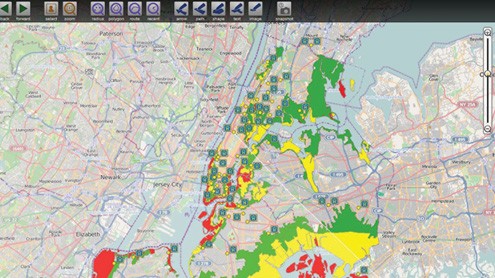Data vs. the deluge: Direct Relief takes high-tech approach against Sandy

Direct Relief is using sophisticated mapping and data technology to better plan a response to Hurricane Sandy. Here, the Goleta-based nonprofit analyzes evacuation zones for Hurricane Sandy in relation to health clinic partners.(courtesy image)
The largest nonprofit in the Tri-Counties is battling it out with Hurricane Sandy, helped by powerful data technology from a Silicon Valley firm.
Goleta-based Direct Relief International has partnered with Palo Alto-based Palintir, a firm that creates big data applications for the federal government and private companies, to better coordinate its response to the massive storm and the crippling destruction left in its wake.
Palintir’s technology allows Direct Relief to determine likely emergency scenarios and take a triage-like approach to dispatching crews and aid to health centers up and down the East Coast, where some 60 million people have been affected by the storm. The idea is that not everyone in a hurricane’s war path is equally at-risk or in need of resources — some areas may have large numbers of very young or very old people more prone to disease, for example, or large numbers of uninsured individuals unable to afford health care.
“The scale of this storm is such that there are a number of places where it’s going to be a long time before people get back on their feet,” Andrew Schroeder, Direct Relief’s director of research and analysis, said in a phone interview from Michigan, one of more than a dozen states rocked by Hurricane Sandy.
Direct Relief has in recent years become much more intensely data-focused, he said. The biggest change occurred several years ago when the international nonprofit started using powerful enterprise software to better coordinate supplies and inventories at its supply warehouses in far-flung places such as sub-Saharan Africa.
About seven months ago, it started to work with Palintir to pull together and overlay massive amounts of data mapping everything from low-income communities to how populations are likely to shift during massive evacuations. Having that information available allows Direct Relief to pinpoint health centers that most need emergency supplies.
Working prototypes of the new technology had just been completed when Hurricane Sandy started barreling toward the East Coast, Schroeder said. “It was fortunate in a way … everything that we had in prototype was ready to go.”
The application pulls data from Direct Relief’s own databases as well as publicly available data provided by agencies such as the Federal Emergency Management Association and the Centers for Disease Control.
Direct Relief cited research by Susan Cutter, director of the Hazards and Vulnerability Research Institute at the University of South Carolina, that indicates that more than 30 variables factor in to a community’s level of vulnerability during a natural disaster. Those factors include the natural and built environment, income levels of the community, and demographic points such as age and race.
In coming weeks and months, Direct Relief will continue to dispatch recovery aid to local clinics in those areas it pinpoints as most at-risk, Schroeder said. “Our policy is to stay engaged with people as long as it takes them to recover,” he said. “We’re still working with people who were affected by Hurricane Katrina.”
Shift in scale
With income last year of $405 million, Direct Relief is by far the largest nonprofit headquartered in the Tri-Counties. The group has about 50 employees on the South Coast. It is also regularly rated as one of the most efficient nonprofits, earning Charity Navigator’s four-star rating for financial management, accountability and transparency — 98.8 percent of its expenses go toward programs, rather than administration and fundraising.
Schroeder said Direct Relief is relying more and more on high-tech applications to help it better prepare for emergencies and to respond faster and more efficiently when disaster strikes.
“We’ve been working with data for a while, and we’ve been doing things like this for a number of years. But this, it’s a shift of scale,” he said. “Palintir is a tool of a different order in terms of its ability to integrate all of the data we need. And it gets better over time as we’re able to learn from the current situation and analyze the new data we’re able to collect.”
The organization, which in recent years has responded to Hurricane Katrina in 2005, the Haiti earthquake in 2010 and the Japanese earthquake and tsunami disaster last year, also runs the largest nonprofit hurricane preparedness program in the U.S. The program was started in 2007, after the fumbled federal response to hurricanes Katrina and Rita in the Gulf states.
Direct Relief now sends large amounts of medicine and supplies to health centers, clinics and hospitals in hurricane-prone areas such as Louisiana and Texas, as well as the Caribbean and Central America, free of charge. The organization said it currently has 50 such “hurricane packs,” each of which contains enough medicine and supplies to treat 100 patients for three to five days, ready at centers across the U.S.
Information on how to donate to Direct Relief can be found at www.directrelief.org/donate.












